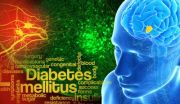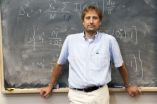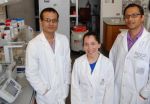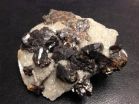(Press-News.org) Most cells do not divide unless there is enough oxygen present to support their offspring, but certain cancer cells and other cell types circumvent this rule. Researchers at The Johns Hopkins University have now identified a mechanism that overrides the cells' warning signals, enabling cancers to continue to divide even without a robust blood supply. In the process, the researchers found that lysosomes — the cell's protein "recycling centers" — help govern cell division decisions. They also uncovered new evidence that certain drugs can halt the growth of tumors that have high levels of the protein HIF-1alpha.
A summary of their findings will be published the week of July 28 in the journal PNAS.
Low levels of oxygen stimulate the production and activation of HIF-1alpha, which protects cells in two ways. Primarily, it turns on several genes for proteins that help the cells adapt to the lack of oxygen. It can also stop the duplication of DNA, which prevents cells from dividing and adding more oxygen-using cells to an already harsh environment.
Knowing that some cells ignore the warnings of HIF-1alpha and divide anyway, Gregg Semenza, M.D., Ph.D., and his team looked for interactions between HIF-1alpha and Cdk1 and Cdk2, proteins known to regulate cell division decisions. They found that HIF-1alpha interacts with both of them, but that Cdk1 increases HIF-1alpha levels, while Cdk2 lowers them.
Semenza's team suspected that Cdk1 and Cdk2 were acting on HIF-1alpha by marking or not marking it for destruction by the cell's miniature "garbage disposals," called proteasomes. But when the researchers blocked proteasome function, they found no changes in HIF-1alpha levels. Instead, Cdk1 and Cdk2 turned out to alter HIF-1alpha levels by marking or not marking it for destruction by the cell's lysosomes. To their knowledge, this is the first time lysosomes have been implicated in a cell's division decisions.
Remarkably, in certain cancer cells, Cdk2 was able to decrease levels of HIF-1alpha while also stimulating its gene activation activity. The net effect was that cells continued dividing while coping with low oxygen levels. In cultured cells, drugs that inhibit Cdk1 prevented HIF-1alpha levels from falling and restored its ability to halt cell division, suggesting they may be effective treatments for certain cancers.
INFORMATION:
Gregg Semenza is the C. Michael Armstrong Professor of Medicine and a professor of pediatrics, oncology, radiation oncology and biological chemistry at the Johns Hopkins University School of Medicine. Other authors of the report include Maimon Hubbi, Daniele Gilkes, Hongxia Hu and Ishrat Ahmed of the Johns Hopkins University School of Medicine; and Kshitiz of Yale University.
This work was supported by grants from the National Cancer Institute (K99CA181352) and the American Cancer Society.
On the Web:
Link to article in PNAS (live after embargo lifts)
Semenza Lab
Cell's recycling center implicated in division decisions
Allows cancer cells to divide even when oxygen-starved
2014-07-28
ELSE PRESS RELEASES FROM THIS DATE:
Facial features are the key to first impressions
2014-07-28
A new study by researchers in the Department of Psychology at the University of York shows that it is possible to accurately predict first impressions using measurements of physical features in everyday images of faces, such as those found on social media.
When we look at a picture of a face we rapidly form judgements about a person's character, for example whether they are friendly, trustworthy or competent. Even though it is not clear how accurate they are, these first impressions can influence our subsequent behaviour (for example, judgements of competence based on ...
Scripps Florida scientists find genetic mutations linked to salivary gland tumors
2014-07-28
JUPITER, FL - July 28, 2014 – Research conducted at the Florida campus of The Scripps Research Institute (TSRI) has discovered links between a set of genes known to promote tumor growth and mucoepidermoid carcinoma, an oral cancer that affects the salivary glands. The discovery could help physicians develop new treatments that target the cancer's underlying genetic causes.
The research, recently published online ahead of print by the Proceedings of the National Academy of Sciences, shows that a pair of proteins joined together by a genetic mutation—known as CRTC1/MAML2 ...
Glucose 'control switch' in the brain key to both types of diabetes
2014-07-28
Researchers at Yale School of Medicine have pinpointed a mechanism in part of the brain that is key to sensing glucose levels in the blood, linking it to both type 1 and type 2 diabetes. The findings are published in the July 28 issue of Proceedings of the National Academies of Sciences.
"We've discovered that the prolyl endopeptidase enzyme — located in a part of the hypothalamus known as the ventromedial nucleus — sets a series of steps in motion that control glucose levels in the blood," said lead author Sabrina Diano, professor in the Departments of Obstetrics, Gynecology ...
Physicists unlock nature of high-temperature superconductivity
2014-07-28
Physicists have identified the "quantum glue" that underlies a promising type of superconductivity -- a crucial step towards the creation of energy superhighways that conduct electricity without current loss.
The research, published online in the Proceedings of the National Academy of Sciences, is a collaboration between theoretical physicists led by Dirk Morr, professor of physics at the University of Illinois at Chicago, and experimentalists led by Seamus J.C. Davis of Cornell University and Brookhaven National Laboratory.
The earliest superconducting materials required ...
Google searches hold key to future market crashes
2014-07-28
A team of researchers from Warwick Business School and Boston University have developed a method to automatically identify topics that people search for on Google before subsequent stock market falls.
Applied to data between 2004 and 2012, the method shows that increases in searches for business and politics preceded falls in the stock market. The study, 'Quantifying the semantics of search behavior before stock market moves,' was published in the Proceedings of the National Academy of Sciences.
The researchers suggest that this method could be applied to help identify ...
Memory relies on astrocytes, the brain's lesser known cells
2014-07-28
VIDEO:
Salk scientists have discovered the link between astrocytes and memory.
Click here for more information.
LA JOLLA—When you're expecting something—like the meal you've ordered at a restaurant—or when something captures your interest, unique electrical rhythms sweep through your brain.
These waves are called gamma oscillations and they reflect a symphony of cells—both excitatory and inhibitory—playing together in an orchestrated way. Though their role has been debated, ...
Scientists discover genetic switch that can prevent peripheral vascular disease in mice
2014-07-28
Millions of people in the United States have a circulatory problem of the legs called peripheral vascular disease. It can be painful and may even require surgery in serious cases. This disease can lead to severe skeletal muscle wasting and, in turn, limb amputation.
At The University of Texas Health Science Center at Houston (UTHealth) Medical School, scientists tested a non-surgical preventative treatment in a mouse model of the disease and it was associated with increased blood circulation. Their proof-of-concept study appears in the journal Cell Reports.
Unlike ...
Mineral magic? Common mineral capable of making and breaking bonds
2014-07-28
TEMPE, Ariz. - Reactions among minerals and organic compounds in hydrothermal environments are critical components of the Earth's deep carbon cycle, they provide energy for the deep biosphere, and may have implications for the origins of life. However, very little is known about how minerals influence organic reactions. A team of researchers from Arizona State University have demonstrated how a common mineral acts as a catalysts for specific hydrothermal organic reactions – negating the need for toxic solvents or expensive reagents.
At the heart of organic chemistry, ...
Forced mutations doom HIV
2014-07-28
CAMBRIDGE, MA -- Fifteen years ago, MIT professor John Essigmann and colleagues from the University of Washington had a novel idea for an HIV drug. They thought if they could induce the virus to mutate uncontrollably, they could force it to weaken and eventually die out — a strategy that our immune system uses against many viruses.
The researchers developed such a drug, which caused HIV to mutate at an enhanced rate, as expected. But it did not eliminate the virus from patients in a small clinical trial reported in 2011. In a new study, however, Essigmann and colleagues ...
Tennessee Surgical Quality Collaborative saves 533 lives and $75 million in 3 years
2014-07-28
NEW YORK (July 28, 2:45 pm [ET]): Ten hospitals in the Tennessee Surgical Quality Collaborative (TSQC) have reduced surgical complications by 19.7 percent since 2009, resulting in at least 533 lives saved and $75.2 million in reduced costs, according to new results presented today at the American College of Surgeons National Surgical Quality Improvement Program (ACS NSQIP®) National Conference in New York City.
The hospital collaborative was formed in 2008 as a partnership of the Tennessee Chapter of the American College of Surgeons and the Tennessee Hospital Association's ...
LAST 30 PRESS RELEASES:
How many insects fly in the sky above the USA?
Could cheese protect your brain health?
Who faces more difficulty recovering from stroke?
Colliding galaxies create the brightest, fastest growing black holes at their center
New BrainHealth research reveals tradeoffs on sleep with cannabis use for chronic pain
Aging-US now on ResearchGate, enhancing visibility for authors and readers
'Molecular glue' stabilizes protein that inhibits development of non-small cell lung cancer
Mount Sinai Health System is recognized in 2025 Chime Digital Health Most Wired survey
From prey to predator: How carnivores spread beneficial fungi
Menopause symptoms may be frequent and have negative effects, according to female endurance athletes
US Congressmembers’ responses on X to mass shooting events differ along party lines
KAIST-UEL team develops “origami” airless wheel to explore lunar caves
Individual genetic differences render some therapies ineffective
Engineering dendritic cells boosts cancer immunotherapy
Sophisticated neuroimaging reveals PTSD in WTC responders is linked to measurable physical changes in brain structure
Health policy experts identify promising strategies for providing health care to homeless people
Study explores role of neutrophils in canine atopic dermatitis
Mayo Clinic researchers develop AI-ECG model to diagnose liver disease earlier
Heavy menstruation common among teenage girls – questionnaire reveals risk of iron deficiency
New study explores why open water swimming feels so powerful for midlife women
In echo of Jurassic Park, mosquitoes capture entire ecosystems in their blood meals
Marty Cooper, Illinois Tech Alumnus and ‘Father of the Cell Phone,’ Receives 2025 Marconi Society Lifetime Achievement Award
How to reduce the risk of lymphedema
NEJM Evidence and CIDRAP announce Public Health Alerts
New fossil study illuminates on the evolutionary success of frogs
Patient-specific human liver model to understand disease mechanisms
Confused by the doctor's questionnaire? U of A study suggests it's common
How do brains stay stable, and when might a dose of flexibility be helpful?
mRNA revitalizes aging immune systems—the liver as a fountain of youth
Rural-urban differences in the prevalence of chronic pain among adult cancer survivors
[Press-News.org] Cell's recycling center implicated in division decisionsAllows cancer cells to divide even when oxygen-starved





